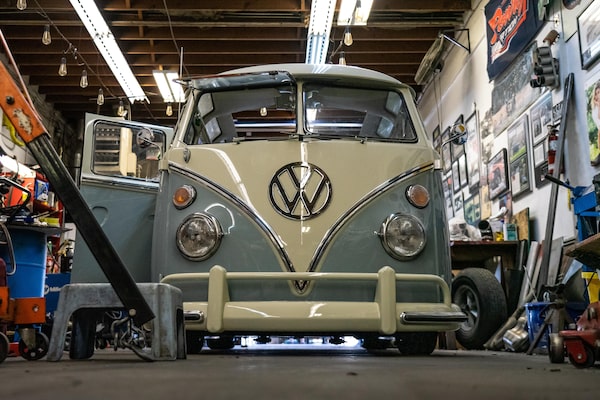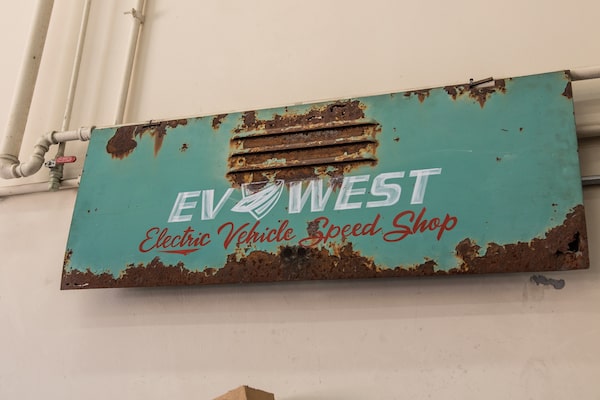
Geoff Peterson's electric-converted 1965 VW Type 2 13-Window Safari Microbus.Brendan McAleer/The Globe and Mail
Geoff Peterson has been creating customized Volkswagens for more than 30 years. This one happens to be electric. A 1965 VW Type 2 13-Window Safari Microbus, it’s got the gorgeous looks of a sixties icon blended with modern electric performance.
Peterson lifts a floor-mounted panel to show a flat array of battery packs hidden away. There’s roughly 200 kilometres of range here, along with significantly more torque and power than the original air-cooled engine supplied.
“You could hide the batteries under the seats,” he explains, “but I wanted this to look as good as possible. We’ve taken our time on this project to really try to create something that’s really perfect.”
The VW Microbus needs just a bleed of the brakes and some light assembly before it’s ready for the local Great Canadian VW Show, to be held on Aug. 22 in Vancouver, B.C. The show will be a bit less of a party than usual, to respect COVID-19 guidelines, but should still attract a respectable crowd of Volkswagen enthusiasts. Peterson, who co-owns Canada Customs & Hot Rods in North Vancouver, B.C., expects to be fielding a lot of questions about what goes into a build like this. He already is.
“I’ve had a lot of people asking me about [EV powertrain] swapping their cars,” he says. “Someone even asked me about converting their [Chrysler] Prowler.”

A floor-mounted panel hides a flat array of battery packs in the VW Microbus.Brendan McAleer/The Globe and Mail
While the 1965 VW project has taken several years to complete, Peterson says that it would now be possible to accomplish a much simpler swap in a much shorter time frame. EV swaps aren’t the science experiments they once were; know-how is growing at the same rate as consumer interest. Peterson also credits pioneering company EV West, a supplier of electric vehicle parts and conversion kits, with providing help on many technical parts of the powertrain assembly.
Owner Michael Bream, speaking from EV West’s headquarters in San Marcos, Calif., says he’s not really interested in becoming a “car conversion” company. “We want to be a supplier. The fabricators already know what they’re doing: cutting metal, welding, creating. We’re just providing our engineering expertise.”
As noted in a previous visit to EV West, there’s a growing interest in converting classic cars to battery power.
The loss of the sound and the smell of combustion power bothers some purists, but these conversions aren’t neutering interesting cars. They’re enhancing them, fitting powerful and reliable powertrains, while keeping much of the magic of owning an old car. In essence, it’s not much different than the very common trick of swapping a modern Chevrolet LS V8 engine into a classic muscle car. Customers can buy internal-combustion motors as crate engines, right from the factory.

EV West is a supplier of electric vehicle parts and conversion kits.Brendan McAleer/The Globe and Mail
In fact, last year EV West offered just such an option, with a crate electric motor designed to replace a V8 in the likes of a Detroit-built classic muscle car. It was a very different experience than working with customizers of European cars like Volkswagens and Porsches, who are loath to change much of anything for fear of devaluing a vehicle’s appeal.
“If you change something in a European car, you’re taking money out of the car,” Bream says. He points out that EV West takes great pains not to cut sheet metal with their conversions, trying to preserve a Porsche 912 or similar in such a condition that a conversion back to combustion power would be possible in less than a day.
“With the American cars, these guys are [automotive] fabricators. They completely rework the suspension, build on an Art Morrison chassis [a provider of modernized automobile frames]. We were saying we could preserve the rear sheet metal, and the builders were responding, ‘Why? I have a tubbed rear anyway.’”
“Tubbing” is a process dating back to 1960s drag racing, where the interior fenders are hollowed out to allow for massive rear tires. Cutting and welding is all part of muscle car culture, including when it comes to battery-powered projects.
To that end, EV West is instead supplying Tesla electric motors that can be fitted directly to the rear axle. The battery pack, weighing roughly 200 kilograms or more, fits where the engine and transmission used to go; the weight of the pack is roughly the same as the gasoline-burning components that are removed.
Before shipping, EV West bench tests the electric motor, controller and battery pack, making sure the controls are running the proper firmware. Bream likens it to dynometer testing a conventional combustion engine, although, in this case, it’s calibrating software rather than tuning fuel injection.

While the 1965 VW project has taken several years to complete, EV swaps aren’t the science experiments they once were.Brendan McAleer/The Globe and Mail
While any muscle car enthusiast will be a big fan of ground-shaking big-block V8s, supercharger whine and smokey burnouts to heat the tires before lining up at the drag racing lights, electric power is ideal for muscle car applications. The cars are heavy anyway, and drag racing is where electric torque excels.
“You know how there’s a manual transmission preservation society?” Bream says with a laugh. “I think we need a burnout preservation society, too.”
Bream and his team are bullish on EV adoption for new cars, particularly with California’s bold zero-emissions strategy. He thinks changing consumer tastes will extend to the classic car market as well. Further the EV West team is all about traditional gearhead culture: working on cars yourself, building unique and interesting machines, adopting the fastest technologies available.
Having broken the Bonneville land-speed record for electric-powered vehicles last year, at just shy of 370 kilometres an hour, EV West is going back this year with company. There are several EV teams looking to establish records, and Bream is optimistic about the growing interest.
“We don’t see other EV companies as competitors,” he says. “We see them as co-promoters.”
For fabricators like Peterson, suppliers like EV West show a way forward. EV conversions aren’t likely to become his main focus in the short term, he predicts, but they are another option that he can provide to those looking to customize their vehicles.
It’s a chance for a future where people who love classic cars don’t have to give them up when gas stations start becoming charging stations. This 1965 VW Safari bus is a little bit different from your average classic Volkswagen build. But it still generates the same thrill, this time with electrons.
Shopping for a new car? Check out the Globe Drive Build and Price Tool to see the latest discounts, rebates and rates on new cars, trucks and SUVs. Click here to get your price.